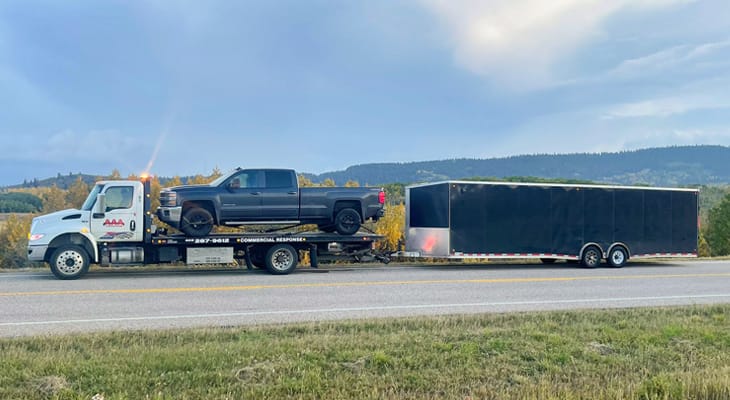Top 5 Misconceptions About Flatbed Towing
September 23, 2024

Flatbed towing is a widely recognized method for transporting vehicles, yet there are several misconceptions surrounding its use. From concerns about vehicle safety to confusion about when it’s necessary, many misunderstandings could lead drivers to make ill-informed decisions when choosing a towing service.
Understanding how flatbed towing works and debunking these myths can help vehicle owners make more informed choices in emergencies or when their car needs transport.
In this article, we will explore the top five misconceptions about flatbed towing and shed light on the facts behind them.
One common misconception is that flatbed towing is primarily reserved for luxury or high-end vehicles. While it is true that flatbed towing is often used for expensive cars due to its safe and secure method of transport, this doesn’t mean it’s only suitable for such vehicles.
Flatbed towing can be used for a wide range of cars, from standard sedans to motorcycles and even heavy-duty trucks.
The versatility of flatbed towing lies in its design. A flatbed tow truck provides a stable platform, reducing the risk of damage that might occur with other towing methods.
Whether it’s a regular vehicle or a vintage classic, flatbed towing offers equal benefits in terms of safety and security during transport.
Therefore, regardless of the vehicle type, opting for flatbed towing ensures minimal risk and maximum peace of mind.
Another misconception about flatbed towing is that it’s more expensive than traditional towing methods. While flatbed towing may sometimes cost more due to the advanced equipment required, this price difference is not always significant. The additional cost often reflects the superior level of safety and care offered by flatbed towing.
When considering towing costs, it’s essential to factor in the potential expenses that could arise from damage to the vehicle. In many cases, using cheaper towing methods like hook-and-chain towing can lead to damage to the vehicle’s undercarriage, tires, or transmission, especially in vehicles with all-wheel or four-wheel drive.
Flatbed towing eliminates this risk by keeping the entire vehicle off the ground, ensuring it is transported safely. Therefore, what may seem like a higher upfront cost for flatbed towing could save considerable money in repair bills later.
Many drivers believe that flatbed towing is only necessary when a vehicle is severely damaged and can no longer be driven or towed using traditional methods. While flatbed towing is certainly ideal in cases of serious damage, such as when a car has been in an accident and cannot roll on its wheels, it’s also beneficial in many other situations.
Flatbed towing is particularly useful for vehicles with low ground clearance, sports cars, or those equipped with specialty modifications like body kits, as traditional towing methods may scrape the vehicle’s bodywork or cause other damage.
It’s also recommended for vehicles with transmission issues or for four-wheel and all-wheel drive vehicles, which can suffer damage if towed using two wheels. In these cases, flatbed towing offers a much safer alternative, preventing further damage and ensuring the vehicle reaches its destination in the best possible condition.
Some drivers believe that flatbed towing is slower and less efficient than other towing methods, particularly when it comes to loading and unloading the vehicle. This misconception stems from the belief that the process of lowering the flatbed, securing the vehicle, and raising the bed back up is time-consuming. However, this is not the case.
Modern flatbed tow trucks are designed for efficiency. The flatbed can be hydraulically lowered and raised in minutes, and the process of securing the vehicle is quick and straightforward.
Additionally, because the vehicle is completely stationary and secured, there is no need to worry about it moving during transport, which can reduce the time spent re-securing or adjusting the car during a trip.
In contrast, traditional towing methods may require additional precautions or adjustments, especially for longer distances or rough terrain, making flatbed towing just as time-efficient.
A final misconception is that flatbed towing may not be safe for all types of vehicles. Some believe that the process of loading and unloading the vehicle onto the flatbed can pose risks, particularly for vehicles with low clearance or non-standard designs. However, this misunderstanding overlooks the versatility and design of modern flatbed tow trucks.
Flatbed towing is one of the safest methods for transporting vehicles, regardless of type. The truck’s adjustable bed allows for safe loading and unloading of even the lowest vehicles, without causing any damage to the undercarriage or body.
Additionally, the vehicle remains stationary throughout the transport, significantly reducing the chances of damage caused by movement or shifting during the journey.
For vehicles that cannot be safely towed with two wheels on the ground, such as all-wheel drive or electric cars, flatbed towing provides a secure, reliable method of transport.
AAA Towing is a trusted towing service provider offering professional and efficient solutions for all types of vehicles. With years of experience and a fleet of modern tow trucks, including flatbed tow trucks, we are committed to delivering safe and reliable services.
We specialize in emergency towing, roadside assistance, and vehicle recovery, ensuring that clients receive prompt and high-quality service whenever they need it. For more information on our services, contact us today.
We make sure each customer is completely satisfied before we leave the job.